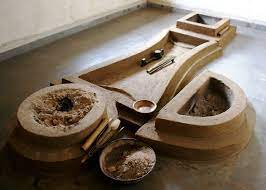At the peak of six Vedangas (Siksha, Nruktham,
Vyaakaranam, Chandas, Kalpa and Jyothisha) the auxiliaries to Vedic Texts, in
which we find the earliest traces of scientific literature, stand the Kalpa,
the science of rituals. Like this, all
these sciences were cultivated in the Vedic shools, the purpose of which was to
make the students conversant with certain holy texts - with some of the
Samhitas, Brahmanas, Aranyakas and Upanishads related with it as well as with
Vedangas.
The sixth Anga or auxiliary is Kalpa which is treated as the pair of hand to the personified Vedic texts. It teaches that how is a rite to be performed, what are the rituals imposed upon the people according to their stages of life namely Bachelor-hood, Household-ship, Forest-Recluses, and Ascetic-hood.
Kalpa contains GruhyaSutras and SrautaSutras for each recension which deal with the 40 samskarasas which are to be performed from the birth to the death of a human being.
A fire altar must be built in order for the Agnicayana ritual to take place. The preparation can take up to a year before the ritual can fully take place, and the timing of the ritual must be precise as well. The ritual must take place in between the time of the new moon and the full moon in spring, and then preparations for the ritual space must be concise and made in sequences “The ritual site is a reconstruction of the cosmos itself, whose dimensions are mirrored in that of the human microcosm. One sees, in this ancient rite, early applications of the astronomical sciences in the necessary timings of each event, of mathematics, in its computations and structural geometries, and of the physical sciences in the casting of bricks, the making of fire, and the offering of oblations”. The fire altar can be made into different shapes, however the most common shape is that of the bird of prey (syena) that is dedicated to the god Agni. Agni has been described as eating the forest, a killer of demons and enemies, and although a god, he is never disengaged from his element, fire. Agni is closely interconnected with the home/family/clan/rituals, being represented by domestic fires that burn constantly; Agni guards the home and all within it. Through the Agnicayana ritual, one prays to Agni to help in the desired outcome of the ritual.






No comments:
Post a Comment